 UK Royal Navy: 12 ships completed: Afridi, Cossack, Ghurka, Mohawk, Tartar, Amazon, Saracen, Crusader, Maori, Nubian, Viking, Zulu (1905-1920)
UK Royal Navy: 12 ships completed: Afridi, Cossack, Ghurka, Mohawk, Tartar, Amazon, Saracen, Crusader, Maori, Nubian, Viking, Zulu (1905-1920)E class: 12 ships.
WW1 British Destroyers:
26 knotters | 27 knotters | 30 knotters | 33 knotters | Turbine destroyers | River class | Cricket class | Tribal class | Beagle class | Acorn class | Acheron class | Acasta class | L class | M class | Repeat M class | Medea class | Faulknor class FL | Marksman class FL | Parker class FL | Talisman class | Shakespeare class FL | R class | S class | Repeat R class | V class FL | Scott class FL | V class | W class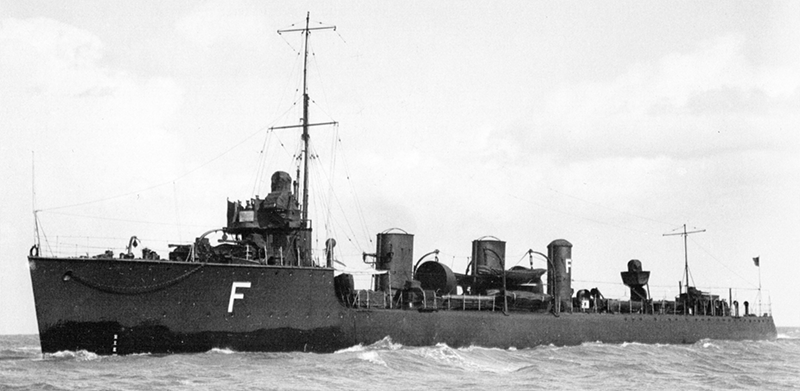
Also known as the “F class” to distinguish them from the more famous WW2 “Tribals” these were an evolution of the River class design, as larger all provided with steam turbines and closed to 950 tonnes fully loaded. Twelve entered service in the Royal Navy, built between 1905 and 1908 and they were all quite busy on World War I, between the North Sea and English Channel in the 6th Flotilla and Dover Patrols. Ghurka was lost to a mine in 1917, Maori too in 1915 off Zeebruge, and Nubian, Zulu were both badly damaged. Fate has it that the first had her stern destroyed and the other her forecastle. Rather to write them off, it was decided to reassemble a new destroyer in shipyard, named “zubian”. She had a new career until 1919, quite an interesting, unique case among WWI destroyers.
Development
 One main objective after the first forecastle destroyers, the River (E-class) destroyers of 1903, was to augment their speed.In majority they were still equipped with VTE engine, not steam turbines as their main disadvantage at the time was a too heavy coal consumption and thus, reduced range. Yest still, for some in the admiralty, speed, not range, was what mattered. Rivers were on average capable of 25.5 knots (47.2 km/h; 29.3 mph) based on 7,000 ihp (5,200 kW) with triple expansion steam engines, HMS Eden being the exception. But by November 1904, First Sea Lord “Jackie” Fisher proposed that the next destroyers would reach 33 knots (61 km/h) based on the new trials specifications (that is, fully loaded and combat ready, in a realistic way). For memory, the few “33 knotters” built in the late 1890s essentially failed. To achieve speed and range he argued they would have to be oil-fired boilers AND giving steam turbines.
One main objective after the first forecastle destroyers, the River (E-class) destroyers of 1903, was to augment their speed.In majority they were still equipped with VTE engine, not steam turbines as their main disadvantage at the time was a too heavy coal consumption and thus, reduced range. Yest still, for some in the admiralty, speed, not range, was what mattered. Rivers were on average capable of 25.5 knots (47.2 km/h; 29.3 mph) based on 7,000 ihp (5,200 kW) with triple expansion steam engines, HMS Eden being the exception. But by November 1904, First Sea Lord “Jackie” Fisher proposed that the next destroyers would reach 33 knots (61 km/h) based on the new trials specifications (that is, fully loaded and combat ready, in a realistic way). For memory, the few “33 knotters” built in the late 1890s essentially failed. To achieve speed and range he argued they would have to be oil-fired boilers AND giving steam turbines.
The only way to achieve this for engineers was to create a larger ship and simply double the installed power and push in general the design to the limits of capability at the time. The Tribals (after the names assigned, peoples under the British rule at the time) were the object of numerous compromises in design and were too lightly built compared to the previous River class. They proved to be be fragile in service and they only had 90 tons of bunkerage, which with their high fuel consumption at 12,500 shp (9,300 kW) limited their radius of action.
Just like for previous classes, they were ordered to several yards already experienced with destroyers. So they differed in internal details, specs, and heterogeneity in appearance, like the number of funnels.
The large Tribals first of the name, were impressive destroyers, but also failed in many ways. Thius trigerred the requirement for a complementary class of smaller “Coastal” destroyers, the Cricket class which were in fact the last classic British Torpedo Boats (TB)s although classed as destroyers. 36 were built between 1905 and 1908 and ended there. They were certainly not ideal. The Royal Navy had iots true destropyer lineage start wit the “G” or Beagle, class, a unitary and more uniform, better balanced design for the 1908-9 programme, marrying speed, range, ruggedness and armament in the same package.
Design of the class
Hull and general design
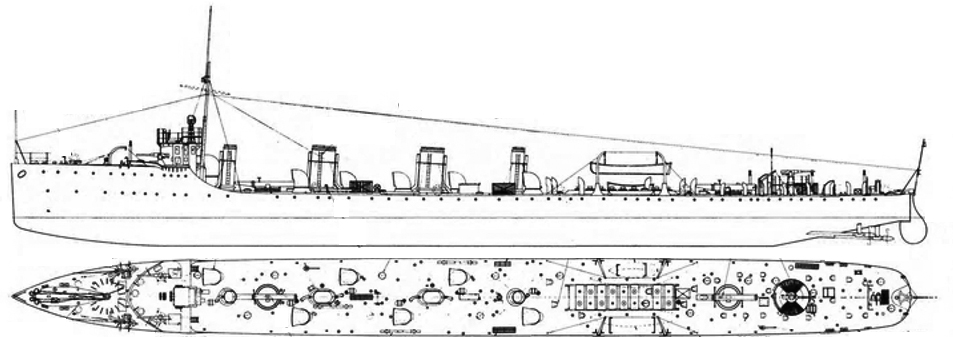
Only reconstitution found, HMS Mohwak. No plans available on line.
The Tribals were the largest destroyers ever built so far in british service. Neither Germany, France or Italy reached these specs yet, being in the 600t range, albeit Russian will have its Novik class a few years down the path and the US were closing on the fleet destroyer concept. Compared to the previous River they were much longer, and shared a forecastle that was relatively short, with a semi-turtle deck, meaning no hard edges but rounded slopes for seawater to be more easily away when submerged. This was also to keep stability. But this was later criticized as too low and seakeeping was poor. Most of the time they were raised and added weight or ballast placed in their hulls to lower the center of gravity.
As said above they were unique in many ways, having a much longer lower deck compared to the Rivers, but also in general three or four funnels often of unequal size with truncated exhausts, albeit this changed: They could have two funnels like the Cossack, Ghurka or even 6 funnels such as HMS Viking (2 single, 2 pairs, only six-funneled ever built). They had a light mainmast aft, and thus became the first two-masted British destroyers.
The bows were almost straight, max beam was reached quickly aft of the forecastle, which was short, about 1/5 of the lenght, to compare to 1/4 for the Rivers and 1/3 of less for subsequent destroyers. In fact it was later found too short to correctly fend off large waves. But unlike the tribals, the bridge was located on it, not aft of it. This was also criticized as water spray was too extensive on the open bridge in heavy weather, hampering operations.
Talking of the bridge, this was a simple wooden-panelled wheelhouse with a bridge platform built on top, with chabdburn and voice pipes and some canvas. There was no roof. A light projector was placed on a platform behind. The prow was well rounded with flat walls, and the single pear-shaped rudder was axially placed at its tip, vulnerable. These ships also had four propeller shafts.
As for characteristics they differed greatly. For displacement: HMS Tartar was at 850 and Afridi at 855 tons standard at the lower end and Crusader was at 1045, Maori at 1026 and Viking at 1090tons and they could reach up to 1000t for Afridi fullu loaded and 1200 tons for HMS Amazon. They ever became later during the war a bith eavier due to additions and modifications.
In dimensions also they differed: For overall lenght this range from 76.2m between pp for Afridi to 85.4m pp for Amazon, Nubian, Viking, Zulu with the “average” at c81m.
In beam also, Afridi again being at the lower end at 7.47m and Viking at the higher end at 8.36m. Draught was about 3.05 meters on average.
Powerplant
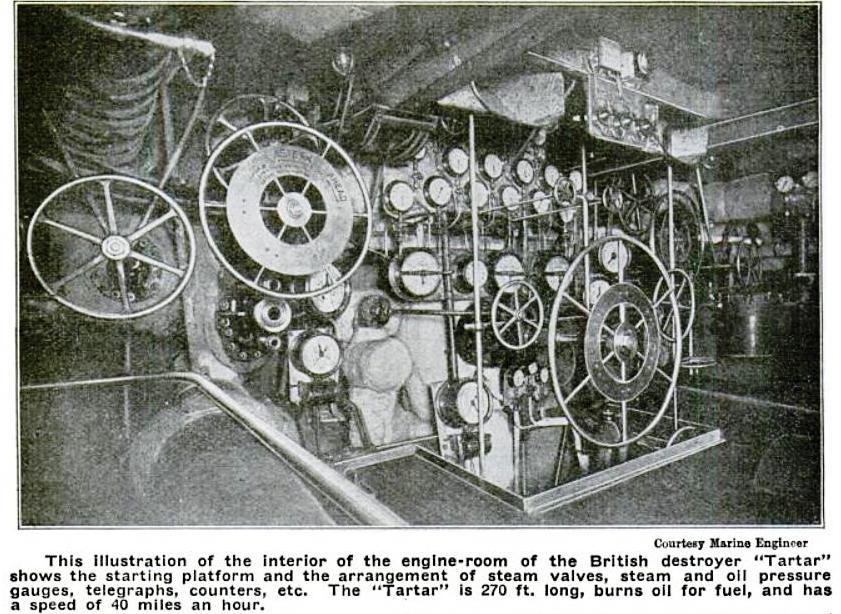
This varied a lot between yards and ships:
Afridi and Ghurka had 3 Parsons steam turbines and 5 Yarrow boilers.
Maori, Zulu, Viking had 3 Parsons steam turbines and 6 Yarrow boilers
Mohawk, Saracen had 3 Parsons steam turbines and 6 White-Foster boilers
Tartar, Amazon, Nubian had 3 Parsons steam turbines and 6 Thornycroft boilers
Cossack had 3 Parsons steam turbines and 5 Laird boilers, and was seen as the fastest of all.
Sea trials showed HMS Mohawk reaching 34.916 knots (64.664 km/h; 40.181 mph), well in excess of the required 33 knots but seakeeping was poor and she rolled badly, so she had to be rebuilt with a raised forecastle for acceptable seakeeping. Other sisters had the same fate. An high consumption example would be the HMS Afridi and Amazon that gobbled 9.5 tons of oil just to raise steam and made a three-mile (5 km) back to the fuel depot. Dur to their appealingly bad range they mostly served “close to home”, in the Channel during the war. They were no matter for fleet destroyer yet.
Specified peak power was to be 14,000 hp, but this of course divereged between ships. Top speed was contracted to 33 knots, and this time, it was reached.
As for range, they carried between 185 and 216tons of fuel oil for an endurance at best of 1,000 nautical miles as specified at 33 knots (1850 km) but this was never approached. Their overall range is not known at cruise speed.
Armament
The first five (first group ordered) were designed to carry three QF 12-pounder guns, better than the single 12-pdr and five 6-pdr guns of the River class. As for torpedoes they kept the same two axial 18-inch (457 mm) tubes. For the secoind group, Saracen sub-class, they received two BL 4-inch (102 mm) guns, one on the forecastle, one on the quarterdeck aft. From October 1908, the first five ships received yet two other 12 pounder gun for five total, including two on either side of the forecastle and two amidships in addition to the one aft at the poop.
It had been realised indeed during construction that the armament of the Tribals was too light, so it was decided to strengthen the armament of the first five ships, including Mohawk, by adding another two 12-pounder guns. Thuis addition was done often during acceptance by the Royal Navy of these ships.
3-in (76mm)/40 12pdr 12cwt QF Mk I
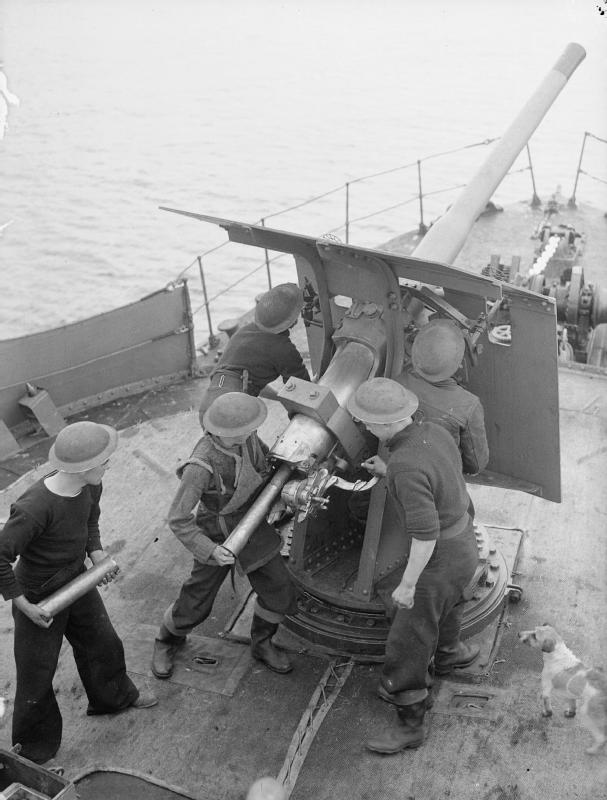
A Mark V in WW2.
Above 4700 of these new 3-in/40 BL rapid fire gun were produced for the RN, also produced under licence in Japan and Italy.
These were unshielded on the Tribals class, at least until some protection was added for the forward guns, more against seawater than enemy shrapnel.
⚙ specifications 3-in/40 BL Mark I (7.62 cm) |
|
| Weight | 12 cwt (0.6 tons, 510 kg) |
| Barrel lenght | 10 ft (3 m), 10 ft 3 in (3.12 m) oa |
| Elevation/Traverse | Mount Dependent, 40° max |
| Loading system | Single-motion screw breech |
| Muzzle velocity | 2,210 ft/s (670 m/s) |
| Range | 11,750 yd (10,740 m) at 40° |
| Guidance | Visual aiming, bridge’s spotting top data |
| Crew | 6 |
| Round | Separate-loading QF |
| Rate of Fire | 15 rounds per minute |
4-in (102mm)/40 BL Mk VIII
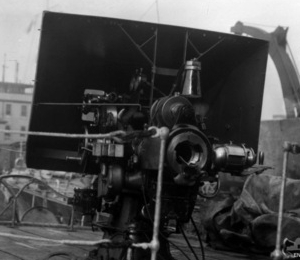 Larger naval gun, the heaviest put on a destroyer to that point. The massive HMS Swift was the first to have some (laid down 1905) and the Tribals had these from the second group onwards. One one the forecastle, one in a raised platform aft and one at the poop.
Larger naval gun, the heaviest put on a destroyer to that point. The massive HMS Swift was the first to have some (laid down 1905) and the Tribals had these from the second group onwards. One one the forecastle, one in a raised platform aft and one at the poop.
⚙ specifications 4 inches/40 Mark 8 (101.6 mm) |
|
| Weight | 2,912 pounds (1,320 kg) (barrel & breech) |
| Barrel lenght | 159.2 inches (4.044 m) |
| Elevation/Traverse | -10° to +20°, 300° |
| Loading system | Welin, single-motion screw breech |
| Muzzle velocity | 2,287 feet per second (697 m/s) |
| Range | 10,210 yards (9,340 m) |
| Guidance | Visual |
| Crew | 8 |
| Round | 31 pounds (14.06 kg) Common pointed, Common lyddite |
| Rate of Fire | 6-8 RPM |
18-in (457 mm) Torpedo Tubes
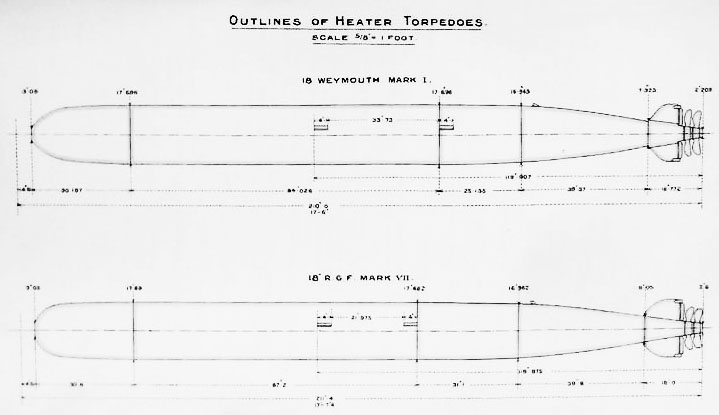
plan of the Mark VII src
The Type used was the 18-inches Whitehead (45 cm) type with a tube aft and another just after the forecastle, both axial with one spare torpedo.
These were initially to be of the Mark VI type used on destroyers of that era (service 1904).
Performance: Compressed air propulsion for 28.5 knots (52.8 km/h; 32.8 mph) for 4,000 yd (3,700 m) or 41 knots (76 km/h; 47 mph) for 1,000 yd (910 m)
However soon the Tribals received their own dedicated type:
The Mark VII and VII* introduced of the 1908 Tribal second group. Also used by the Cricket class and next destroyer class and later by RAF flying boats in the 1920s.
⚙ specifications 18-in TT |
|
| Dimensions | 210 in (5.3 m) x 17.6 inches (44 cm) |
| Propulsion | Wet-heater |
| Range/speed setting Mark VII | 30 kts/6,000–7,000 yd or 41 kts/3,000 yd (2,700 m) |
| Range/speed setting Mark VII* | 29 kts/7,000 yd (6,400 m) or 35 kts/5,000 yd (4,600 m) |
| Warhead | 320 lb (150 kg) TNT |
The Tribals in operation

Given their poor range, they were impressed in the Dover patrol at the start of the war, roaming the channel. They had to fend off often raids from German TBs and destroyers of the Flanders flotilla as well as small subs of the UB-1 types. The first mission was to escort troopships of the BEF to France, and other convoys, protect netlayers and netwatchers and of course, anti-submarine warfare (ASW) with the greatest threat being minelayer submersibles (UC types).
They lacked proper ASW means, neither for detection or attack at the time. The usual method was just spotting one and try to run at and ram her before she submerged. This was sometomes fatal for the frail construction of these vessels. Liners and battleships had more success… Of course firing at them was the preferred method for the admiralty, but given the small size of the target
One of the main means of detecting submerged submarines in 1914 was the indicator net, in which a submarine would get caught up, the movement trigerring the attached buoy indicating the location of the submarine.
Nets were established across the possible path taken by submarines and raised alarm. ASW grenades were introduced at the very end of the war. Meanwhile, destroyers used various devices like a large metallic bedframe like systems with hooks destined to “catch” and raised to the surface a submarine, where it could be finished off by gunfire. The anti-submarine sweep was one of these. Guncotton bombs were also dropped, endangering the vessel itself. The Royal Navy torpedo establishment HMS Vernon, designed explosive grapnel sweeps which sank four or five U-boats in the First World War. Later other destroyers tested a string of 70 lb (32 kg) charges on a floating cable that were fired electrically.
The Tribals class were of weak construction, and two lost on mines. Two more however did not sank and were reunited into the famous “Zubian” for few more years of service. They were all retired between 1919 and BU up to 1922. The WW2 namesake “tribals”, far better known, were certainly the best destroyers in service with the British RN and copied by the Australians and Canadians.
 Afridi
Afridi
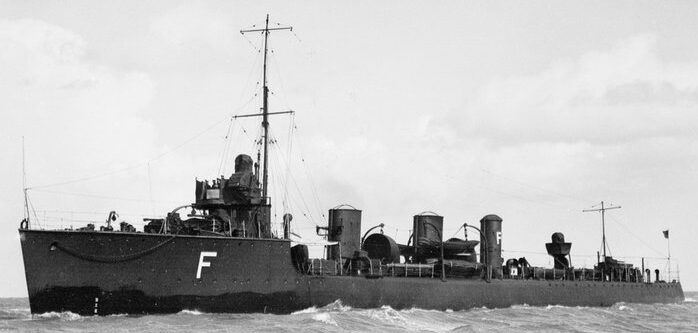
She was laid down at Armstrong Whitworth, Newcastle upon Tyne on 9 August 1906, launched on 8 May 1907 and completed on 7 September 1909. On 10 September 1909 as the last destroyer to be built by Armstrongs she joining the 1st Destroyer Flotilla until 1913, then the 4th Destroyer Flotilla at Portsmouth. By February 1914, she was reassigned to Dover’s 6th Destroyer Flotilla. In WWI she took part of the Dover Patrol. On 20 February 1915 she spotted a disturbance in indicator nets, and deployed her explosive anti-submarine sweep, for naught. On 6 April 1915, the drifter Hyacinth spotted a periscope, SM U-33. Afridi nearby ran for it, but the indicator buoys did not deploy and she escaped. On 24 March 1916, the cross-Channel ferry Sussex was torpedoed by SM UB-29. Afridi too, part in the rescue operations.
With the appearance of German destroyers armed with 105 mm guns from the Flanders Flotilla, the rearly Tribal group were rearmed, 12-pounder guns replaced by two 4.7-inch (120 mm) QF guns up to October 1917 and a single 2-pounder “pom-pom” AA autocannon plus a Maxim machine gun also for AA.
On 22–23 April, Afridi took part in the raid on Ostend which took place at the same time on Zeebrugge, as the escort for blockships HMS Sirius and HMS Brilliant. But this was a failure, as the blockships missed the entry to the harbour and run aground. Decommissioned, she was sold Immingham in November 1919 but instead sunk as a target on 9 April 1930.
 Cossack
Cossack
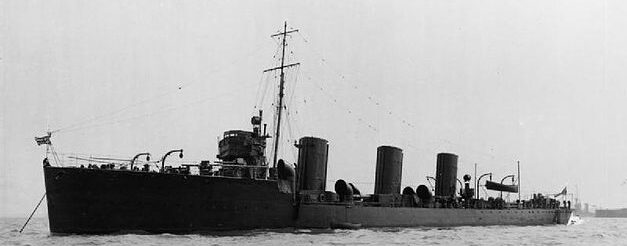
Cossak was laid down at Cammell Laird, Birkenhead on 13 November 1905, launched on 16 February 1907 and commissioned on 12 March 1908. Shortly after entering service, she received another two 12 pounder guns in 1909. Her Captain reported she was a poorer sea boat than River-class destroyers but better gun platform. After the First Destroyer Flotilla in 1913, this was the 4th Destroyer Flotilla, Portsmouth, until January 1914, and then, the Dover 6th Destroyer Flotilla. By 23 August 1914 she collided with her sister Ghurka and by October 1914, she bombarded german positions during the Battle of the Yser. On 20 October 1914, after Amazon was damaged by German shellfire, Rear Admiral Horace Hood transferred his flag to Cossack. On the night of 26/27 October 1916 she was part of a six Tribal-class destroyers attack from the Dover harbour, and with Amazon sustained lesser damage from German gunfire.
On 1 July 1917, she collided with the transport SS The Duchess, near Eastbourne and her depth charges exploded, sinking The Duchess and blowing her stern. She was towed to Dover for repair but on 16 September 1918, a fire started in HMS Glatton’s magazines so it was decided to sink her, Cossack firng two torpedoes. One was a dud, the other just was defeated by its bulge. Instead she was sunk by 21 inch torpedoes from HMS Myngs. Cossack was sold to Thos. W. Ward on 12 December 1919 for BU.
 Ghurka
Ghurka
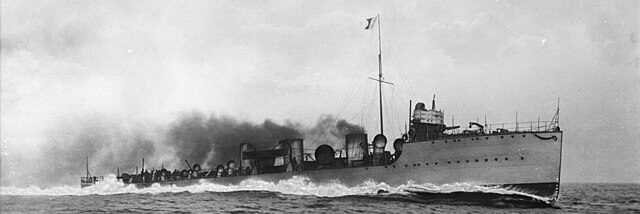
Ghurka was laid down at Hawthorn Leslie and Company in Newcastle upon Tyne on 6 February 1906 and launched on 29 April 1907. She was commissioned on 17 December 1908. But during construction on 9 January 1908 she coal steamer Hartley sheered and collided with Ghurka, moored near the Hawthorn Leslie’s shipyard with extensive damage to her port quarter. On 13 August 1908 the steamer City of Naples also collided with Ghurka when moored near Hebburn Buoys, and mushed her starboard side so repairs saw her delayed.
From 1910 to 1913, she served with the 1st Destroyer Flotilla, then 4th Flotilla, Portsmouth, the 6th Destroyer Flotilla, Dover but she was damaged in a collision with her sister HMS Cossack on 23 August 1914 ahd was repaired again in dry dock. On 4 March 1915 U-8 became caught in nets in the Straits, reported to the drifter Roburn, which called up the nearest patrol, including Ghurka but also Viking, Maori and Nubian. Viking’s sweep had no effect, but Maori spotted her and Ghurka used her own explosive sweep to force her out. On the surfaced she was shelled, the crew surrendered and she was scuttled. On 10 March 1915, Ghurka made another explosive sweep and “probable” kill at the time. It was not. She took part in the bombardment of Zeebrugge on 23 August 1915.
On 8 February 1917 she hit a German mine off Dungeness (5 survived) and sunk under 30 metres, now a “protected place”.
 Mohawk
Mohawk
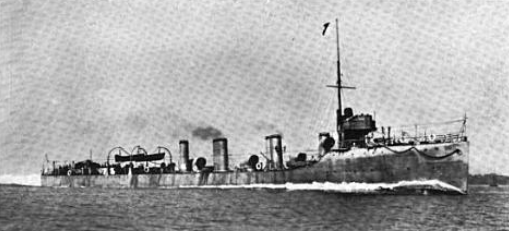
Mohawk was laid down at J Samuel White, Cowes (Isle of Wight) on 1 May 1906, launched 15 March 1907 and completed in June 1908. 1st Destroyer Flotilla, Home Fleet until 1913, transferred to the 4th Destroyer Flotilla in Portsmouth. She was sent to Dover, 6th Destroyer Flotilla due to her range like her sisters: The famous Dover Patrol. She escorted the British Expeditionary Force to France. On 6 October she spotted an U-Boat and charged, the latter submerged and escape, and the escort were unharmed. On 1 June 1915 she entered the minefueld laid by SM UC-11 south of the Downs and struck one. She had 5 killed and all power failed. She was was towed back to Dover her decks near awash due to the flooding. These sub-laid mines were small, if not she would have broke in two.
On the night of 26/27 October 1916, German torpedo boats from the Flanders Flotilla raided the English Channel, attacking drifters watching over the anti-submarine nets of the Dover Barrage and six Tribal-class were scrambled when HMS Flirt reported the attack. They split up, Viking leading Mohawk and Tartar and they encountered the German 18th Half Flotilla. Hits kill four aboard Mohawk and her steering was jammed, Viking had to nearly stop to avoid a collision and the Germans escaped. Mohawk remained with the 6th Flotilla until 3 October 1917 and joined the 10th Submarine Flotilla as leader until 11 November 1918. She was sold for scrap on 27 May 1919.
 Tartar
Tartar
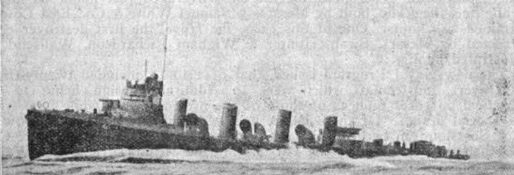
HMS Tartar was laid down at JI Thornycroft, Woolston on 13 November 1905, launched on 25 June 1907 and completed on 9 April 1908. She had the same career as her sisters, at the 1st Destroyer Flotilla Home Fleet, 4th Destroyer Flotilla Portsmouth in 1913, then 6th Destroyer Flotilla at Dover in 1914. On 8 September 1915, HMS Leven collided with a transport and was towed stern first back to Dover assisted by Tartar, Viking and the tug Lady Crundall.
On the night of 26/27 October 1916, there was a battle against German destroyers, Tartar followed Mohawk while Viking had her path blocked by Mohawk so the German torpedo boats escaped successfully. She took no hit and had no wounded.
However luck ran off when she hit a German mine on 17 June 1917 (43 killed, with captain, G. K. Twiss). She survived and was towed to safety. By November 1917 she was in the 11th Destroyer Flotilla in Blyth, Northumberland, a cushy sector. On 18 February 1918, she collided with the merchant ship Ardgantock off Hartlepool. She was repaired and reassigned to the 11th Submarine Flotilla on 11 November 1918. She was sold for scrap on 9 May 1919 to Thos. W. Ward of Hayle.
 Amazon
Amazon
<
Amazon was the lead ship of the second group. She was laid down also at J I Thornycroft on 24 June 1907, launched 29 July 1908 and completed on April 1909. Same way as the others, North Sea and English Channel with the 6th Destroyer Flotilla at Dover but no detailed records. She survived the War and was sold in 1919.
 Saracen
Saracen
Saracen was laid down at J Samuel White on 12 July 1907, launched 31 March 1908 and completed on 25 June 1909. Originally allocated to the 1st Destroyer Flotilla, she served in the North Sea and the English Channel with the 6th Destroyer Flotilla at Dover like her sisters and survived the war. She was sold for scrap in 1919.
 Crusader
Crusader
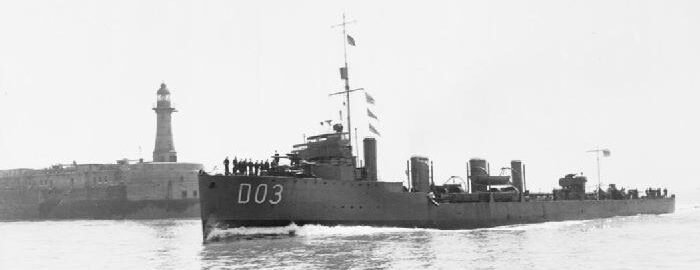
She was laid down at J.Samuel White on 22 June 1908, launched on 20 March 1909 and completed on 21 October 1909. he served in the North Sea and the English Channel with the 6th Destroyer Flotilla.
Sold on 30 June 1920 for breaking up.
 Maori
Maori
Maori was laid down at William Denny & Brothers of Dumbarton on 6 August 1909 and she was launched on 24 May 1909, completed on 11 November 1909. She joined the 1st Destroyer Flotilla in Harwich, replacing the River-class destroyer Dee. By March 1913, she was assigned to the 4th Destroyer Flotilla of the First Fleet. During the First World War, she served in the North Sea and the English Channel with the 6th Destroyer Flotilla in Dover, and struck a mine in the North Sea on 7 May 1915 off Wirlingen Light Ship Zeebrugge and sank with all hands.
 Nubian
Nubian
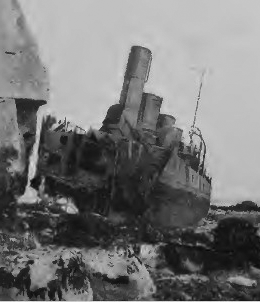 Nubian was laid down at JI Thornycroft on 18 May 1908; launched on 21 April 1909, completed on 24 August 1909. She was first based in the 1st Destroyer Flotilla, Harwich (east coast defence area) and took part in exercises at the Cromarty Firth with Saracen, Mohawk and Ghurka. They were at the parade at Penzance in July 1910 and she had a refit at Chatham. By March 1911 she was based to Portland, 2nd Destroyer Flotilla and to Plymouth, then Kirkwall in May 1911 and by June for the naval review at Spithead. After a refit at Chatham in May 1912 she was versed to the 4th Destroyer Flotilla, Portland and in exercises in the English Channel with Amazon and Zulu, led by the cruiser Bristol, 2dn Cruiser Squadron. After another refit at Chatham in September 1912 and stop at Sheerness she was based at Portland by January 1913. She became top scorer in the 1912 battle practice. By February 1914 she was versed to the 3rd Destroyer Flotilla but by May 1914 she became tender for the gunnery establishment HMS Excellent.
Nubian was laid down at JI Thornycroft on 18 May 1908; launched on 21 April 1909, completed on 24 August 1909. She was first based in the 1st Destroyer Flotilla, Harwich (east coast defence area) and took part in exercises at the Cromarty Firth with Saracen, Mohawk and Ghurka. They were at the parade at Penzance in July 1910 and she had a refit at Chatham. By March 1911 she was based to Portland, 2nd Destroyer Flotilla and to Plymouth, then Kirkwall in May 1911 and by June for the naval review at Spithead. After a refit at Chatham in May 1912 she was versed to the 4th Destroyer Flotilla, Portland and in exercises in the English Channel with Amazon and Zulu, led by the cruiser Bristol, 2dn Cruiser Squadron. After another refit at Chatham in September 1912 and stop at Sheerness she was based at Portland by January 1913. She became top scorer in the 1912 battle practice. By February 1914 she was versed to the 3rd Destroyer Flotilla but by May 1914 she became tender for the gunnery establishment HMS Excellent.
By March 1915 she hunted down SM U-8 later sunk by Ghurka and Maori. She later bombarded the coast of Belgium in October–November 1914 and was present at the Battle of Dover Strait on the night of 26–27 October 1916. While off Folkestone her bow was almost severed by a German torpedo. The impact was below her bridge. She towed in the bad weather, the ropes broke and she ran aground on the South Foreland near Dover, loosing her bow. 13 were missing.
She was refloated from rocks and condutected to Chatham to meet her sister Zulu, which had her stern blown off near Dunkirk on 8 November 1916 and engineers decided to join both via their midsection. The portmanteau “Zubian” served until the end of the war (see below). But Nubian in effect was stricken by 27 October 1916.
 Viking
Viking
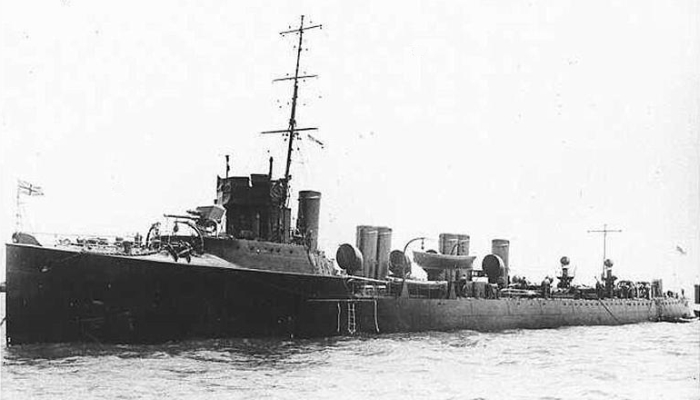
Viking was laid down at Palmers, Jarrow on 29 June 1910, launched on 11 June 1908 and completed on 14 September 1909, commissioned on 29 June 1910. After the 1st Destroyer Flotilla until 1913, and a short tour by the 4th, she ended with the 6th at Dover. By October 1914 she shelled German positions in the Battle of the Yser but lost her forward gun when it exploded, wounding 2. She was repaired. On 20 February 1915, while patrolling she spotted indicator buoys being disturbed and called for help Afridi and drifters. They made an ASW sweep for naught. On 4 March 1915, U-8 was caught in the nets, spotted by the drifter Roburn adn she was called as Ghurka, Maori and Nubian. Viking fired her explosive sweep and Maori, Ghurka used her own, forced her to surface after which she surrendered.
Viking struck a mine near the Colbart Bank on 29 January 1916 (10 killed) and by the night of 26/27 October 1916, she took part in a short brawl against German torpedo boats of two units of the Flanders Flotilla. Viking led Mohawk and Tartar from the Western entrance to the port. Later Mohawk was hit and started drifting in front of Viking in hot pursuit, so she had to stop. They escaped.
In 1916, Viking was experimentally rearmed with a BL 6-inch (152 mm) Mk VII with HMS Swift but of course it proved too large and was later removed. By late 1916 she received a QF 4-inch Mk V gun. She ended the war in the same unit, without anything noticeable, and was sold on 12 December 1919 for breaking up.
 Zulu
Zulu
Zulu was laid down at Hawthorn Leslie and Company, Newcastle upon Tyne and launched 18 August 1908, completed on 16 September 1909 and commissioned on 19 March 1910, joining the 1st Destroyer Flotilla until 1913, then 4th Destroyer Flotilla in Portsmouth and then in 1914 Dover, 6th Destroyer Flotilla like her sisters, the entire F class.
Zulu captured the German sailing ship Perhns on 5 August 1914. But she collided with her sister ship Crusader in August and September. By 24 April 1916 she covered an operation to lay mines and nets off Ostend and Zeebrugge. Zulu and Nubian laid lines of dan-buoys to mark positions of minefields and nets to be laid. 1,565 mines were laid by the minelayers Princess Margaret, Orvietto, Paris and Biarritz. It claimed UB-13 (reported cartain) and 4-5 more presumed. On 8 November 1916, Zulu hit a mine laid by UC-1 while off Dunkirk, it epxloded just under the engine-room (3 killed) and her whole stern broke off and sunk. She was however soon towed to safety in Calais by the French destroyer Capitaine Mehl adn then by British tugs to to Chatham, where it was decided to fuse her with her sister Nubian which missed her bows. The new destroyer was called Zubian, commissioned on 7 June 1917 while herself was stricken.
 Zubian
Zubian

On 8 November 1916 the two undamaged ends of both Zulu and Nubian were joined together rather than striking both vessels outright, a work completed at Chatham Royal Dockyard on 7 June 1917 (fore section of Zulu, rear section of Nubian). That was a feat due to both coming from different designs. The resulting “Zubian” as named jockingly by Admiral Reginald Bacon, the commander of the Dover Patrol also confused German intel, which believed the Dover Patrol had a new destroyer. She was officially commissioned on 7 June 1917 and see some service until the end of the war: She joined the 6th Flotilla until the end of the war, rotating through nighttime patrols in the Dover Strait in groups of four supported by cruisers or destroyers flotilla leaders. They tried to catch German torpedo boats making night raids in the Channel. By 4 February 1918 she surprised UC-50 surfaced about 400 yards (370 m) off her port bow trying to comminucate with HQ, radio antennae up. This was so short she tried to ram her, but the Germans managed to submerge. She dropped depth charges and later observed oil and wreckage so she marked the location with a buoy and later HMS P12 dropped additional depth charges and Trawlers confirmed the sinking of UC-50.
She took part in the First Ostend Raid on the night of 23–24 April, assigned to the bombardment force, with HMS Mentor and Lightfoot escorting six monitors. The bombardment was also covered by the Harwich Force, trying to cancel the German coastal defences while twop decommissioned cruisers attempted to block the harbour entrances, but failed due to navigation error.
Worn out, Zubian was sold in December 1919. A fairly short career for a very odd destroyer indeed.
Read More/Src
Books
Colledge, J. J.; Warlow, Ben (2006) [1969]. Ships of the Royal Navy: Complete Record of all Fighting Ships of the Royal Navy , Chatham Publishing.
Dittmar, F.J.; Colledge, J. J. (1972). British Warships 1914–1919. Shepperton, UK: Ian Allan.
Friedman, Norman (2009). British Destroyers: From Earliest Days to the Second World War. Barnsley, UK: Seaforth Publishing.
Gardiner, Robert & Gray, Randal, eds. (1985). Conway’s All The World’s Fighting Ships 1906–1921. London: Conway Maritime Press.
Manning, T. D. (1961). The British Destroyer. London: Putnam & Co.
March, Edgar J. (1966). British Destroyers: A History of Development, 1892–1953; Ships’ Covers & Building Plans. London: Seeley
Links
https://en.wikipedia.org/wiki/Tribal-class_destroyer_(1905)
https://www.militaer-wissen.de/destroyer-hms-viking/?lang=en
https://commons.wikimedia.org/wiki/Category:Tribal_class_destroyer_(1905)
http://www.dreadnoughtproject.org/tfs/index.php/18-in_Mark_VII_Torpedo_(UK)
christies.com/ 1/96 model

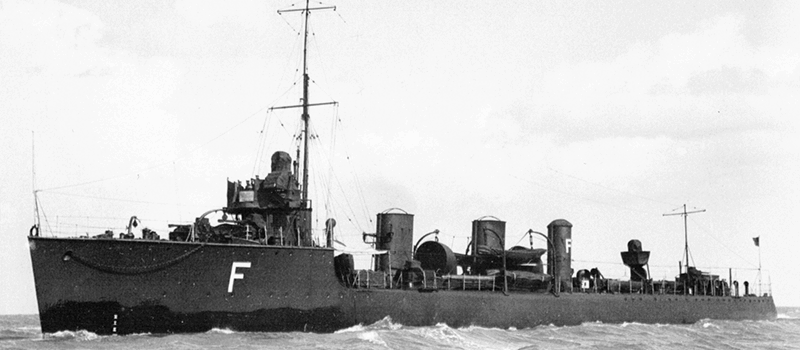
 Latest Facebook Entry -
Latest Facebook Entry -  X(Tweeter) Naval Encyclopedia's deck archive
X(Tweeter) Naval Encyclopedia's deck archive Instagram (@navalencyc)
Instagram (@navalencyc)





 French Navy
French Navy Royal Navy
Royal Navy Russian Navy
Russian Navy Armada Espanola
Armada Espanola Austrian Navy
Austrian Navy K.u.K. Kriegsmarine
K.u.K. Kriegsmarine Dansk Marine
Dansk Marine Nautiko Hellenon
Nautiko Hellenon Koninklije Marine 1870
Koninklije Marine 1870 Marinha do Brasil
Marinha do Brasil Osmanlı Donanması
Osmanlı Donanması Marina Do Peru
Marina Do Peru Marinha do Portugal
Marinha do Portugal Regia Marina 1870
Regia Marina 1870 Nihhon Kaigun 1870
Nihhon Kaigun 1870 Preußische Marine 1870
Preußische Marine 1870 Russkiy Flot 1870
Russkiy Flot 1870 Svenska marinen
Svenska marinen Søværnet
Søværnet Union Navy
Union Navy Confederate Navy
Confederate Navy Armada de Argentina
Armada de Argentina Imperial Chinese Navy
Imperial Chinese Navy Marinha do Portugal
Marinha do Portugal Mexico
Mexico Kaiserliche Marine
Kaiserliche Marine 1898 US Navy
1898 US Navy Sovietskiy Flot
Sovietskiy Flot Royal Canadian Navy
Royal Canadian Navy Royal Australian Navy
Royal Australian Navy RNZN Fleet
RNZN Fleet Chinese Navy 1937
Chinese Navy 1937 Kriegsmarine
Kriegsmarine Chilean Navy
Chilean Navy Danish Navy
Danish Navy Finnish Navy
Finnish Navy Hellenic Navy
Hellenic Navy Polish Navy
Polish Navy Romanian Navy
Romanian Navy Turkish Navy
Turkish Navy Royal Yugoslav Navy
Royal Yugoslav Navy Royal Thai Navy
Royal Thai Navy Minor Navies
Minor Navies Albania
Albania Austria
Austria Belgium
Belgium Columbia
Columbia Costa Rica
Costa Rica Cuba
Cuba Czechoslovakia
Czechoslovakia Dominican Republic
Dominican Republic Haiti
Haiti Hungary
Hungary Honduras
Honduras Estonia
Estonia Iceland
Iceland Eire
Eire Equador
Equador Iran
Iran Iraq
Iraq Latvia
Latvia Liberia
Liberia Lithuania
Lithuania Mandchukuo
Mandchukuo Morocco
Morocco Nicaragua
Nicaragua Persia
Persia San Salvador
San Salvador Sarawak
Sarawak Uruguay
Uruguay Venezuela
Venezuela Zanzibar
Zanzibar Warsaw Pact Navies
Warsaw Pact Navies Bulgaria
Bulgaria Hungary
Hungary

 Bundesmarine
Bundesmarine Dutch Navy
Dutch Navy Hellenic Navy
Hellenic Navy Marina Militare
Marina Militare Yugoslav Navy
Yugoslav Navy Chinese Navy
Chinese Navy Indian Navy
Indian Navy Indonesian Navy
Indonesian Navy JMSDF
JMSDF North Korean Navy
North Korean Navy Pakistani Navy
Pakistani Navy Philippines Navy
Philippines Navy ROKN
ROKN Rep. of Singapore Navy
Rep. of Singapore Navy Taiwanese Navy
Taiwanese Navy IDF Navy
IDF Navy Saudi Navy
Saudi Navy Royal New Zealand Navy
Royal New Zealand Navy Egyptian Navy
Egyptian Navy South African Navy
South African Navy






























 Ukrainian Navy
Ukrainian Navy dbodesign
dbodesign